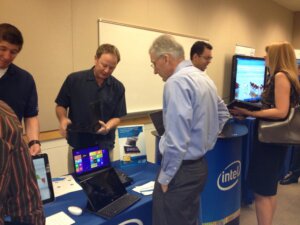The PC world is dead? Chris Hubbard, Intel’s Business PC Marketing Manager scoffs at the mere idea. “The demise of the PC industry was predicted before it was born!” he said during his opening presentation at the SEMI Americas Arizona Breakfast Forum, Friday April 12, 2013 at Intel in Chandler, AZ. Hubbard showed a chart contrasting PC revenue growth with different times over the years when the PCs fate was doomed to extinction. Rather than its passing, Hubbard says we are going through a period of massive transition that will result in the reinvention of the PC.
Hubbard quoted Andy Grove, former Intel CEO and pioneer of the semiconductor industry as saying “The PC is the ultimate Darwinian Device.” The PC adapts, and we can engineer our way out of the situation. “We are taking what is impossible and making it possible,” said Hubbard. He was talking about the Ultrabook, which he says exemplifies the PC evolution. It took 6 months from design to development, and went mainstream in 2012. “Every engineer is being challenged,” he said, “There has been a radical change in how we build PCs. Existing chips weren’t designed to go into a device this thin (referring to the Ultrabook). We had to retrofit them but we made it work.” This summer, Intel will launch chips designed to go into Ultrabooks, and the result will be all-day computers that are light as an iPad but have the power of a PC. Hubbard predicts that existing devices will absorb tablet technology. The tablet won’t be the final product; it will just lead us to a new type of PC.

Cool examples of this showcased by Intel included a touch-screen convertible tablet/notebook; Dell’s carousel screen, and th NUC desktop tower that is roughly the size of a VHS cassette (and smaller). “Don’t let the naysayers get you down,” he urged.
Other speakers of the morning talked about other maturing markets such as MEMS, (Tony Massimini, SEMICO Research) Photovoltaics (Mani TamizhMani, TUV Rheinland PC Testing Lab) and LEDS (Sri Jandhylaya, ON Semiconductor).
Massimini reported that MEMS ASPs are coming down, which inspires OEMs to add more MEMS-based features to their products. As an example of new applications driving MEMS innovation, Massimini talked about “The Internet of Things”, which he expanded to the “Internet of Things and People” because MEMS devices now allow for monitoring activity of things AND people to create personal health and fitness hubs.
Similarly, Jandhylaya talked about the rapidly evolving LED market. As the ban on incandescent lighting moves across the globe (Beijing is targeting 2015 for LED to comprise 30% of total lighting, Taiwan expects 15% LEDs, Japan has already achieved 30% LED penetration, and phase-out of Incandescent lightbulbs in the US started in 2011), and the per unit price of LED bulbs comes down, LED will take off.
He says we’re now in phase 1 of this transition, with adoption of retrofitted lamps. “Smart” lighting will start to grow in 1-5 years, driven by the Internet of Things and command control.
What does any of this have to do with 3D ICs? First of all, the Internet of Things referenced by both Massimini and Jandhylaya will be enabled by 3D integration. In particular, Massimini pointed to packaging innovation integrating multiple MEMS in one package.
Secondly, “lessons learned” comparisons to 3D IC market adoption can be drawn, such as the increased demand and expanding application spaces of both MEMS and LEDs as unit prices come down and mainstream volume activity is reached. For 3D ICs, those lessons will be learned in high computing applications, and similar takeoff will take place for consumer products as the price comes down and the performance enhancements can be realized. ~ F.v.T





















